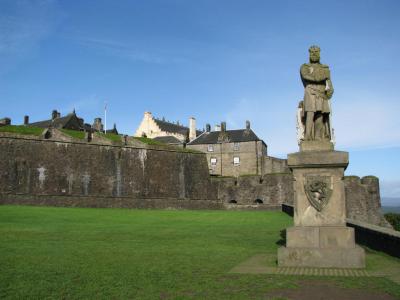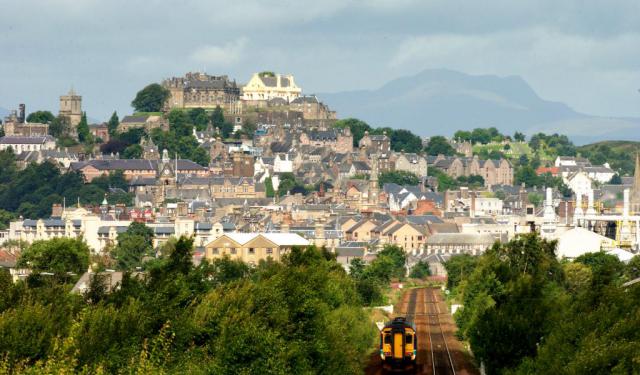
Robert The Bruce Monument, Stirling
The Robert the Bruce Monument at Stirling Castle is a striking tribute to one of Scotland’s most iconic kings, who ruled from 1306 to 1329. Created by Scottish sculptor Andrew Currie between 1876 and 1877, the statue reflects the growing public interest in Scottish history during the 19th century, with the project being funded by public subscription.
The stone figure of Bruce is designed as a tall, commanding presence, clad in chain-mail armor. His hand rests on the pommel of his sword, while his shield and axe lie at his feet. The pedestal features a replica of Bruce's shield, displaying the Lion Rampant, a symbol of Scottish royalty. Some metal elements, such as the axe head, sword, and parts of the shield, were incorporated into the statue, although it's uncertain whether they were part of the original design or later restorations.
Facing south, the statue looks towards Bannockburn Battlefield, where Bruce achieved a crucial victory over the English in 1314, solidifying Scottish independence for a time. The monument at Stirling Castle serves as a counterpart to another statue of Bruce, an equestrian version by Pilkington Jackson, located at the Bannockburn Visitor Centre, created in 1964.
In 2020, the Robert the Bruce monument at Stirling Castle was featured on the Clydesdale Bank's £20 note, further cementing its cultural and historical significance.
The stone figure of Bruce is designed as a tall, commanding presence, clad in chain-mail armor. His hand rests on the pommel of his sword, while his shield and axe lie at his feet. The pedestal features a replica of Bruce's shield, displaying the Lion Rampant, a symbol of Scottish royalty. Some metal elements, such as the axe head, sword, and parts of the shield, were incorporated into the statue, although it's uncertain whether they were part of the original design or later restorations.
Facing south, the statue looks towards Bannockburn Battlefield, where Bruce achieved a crucial victory over the English in 1314, solidifying Scottish independence for a time. The monument at Stirling Castle serves as a counterpart to another statue of Bruce, an equestrian version by Pilkington Jackson, located at the Bannockburn Visitor Centre, created in 1964.
In 2020, the Robert the Bruce monument at Stirling Castle was featured on the Clydesdale Bank's £20 note, further cementing its cultural and historical significance.
Want to visit this sight? Check out these Self-Guided Walking Tours in Stirling. Alternatively, you can download the mobile app "GPSmyCity: Walks in 1K+ Cities" from Apple App Store or Google Play Store. The app turns your mobile device to a personal tour guide and it works offline, so no data plan is needed when traveling abroad.
Robert The Bruce Monument on Map
Sight Name: Robert The Bruce Monument
Sight Location: Stirling, Scotland (See walking tours in Stirling)
Sight Type: Attraction/Landmark
Guide(s) Containing This Sight:
Sight Location: Stirling, Scotland (See walking tours in Stirling)
Sight Type: Attraction/Landmark
Guide(s) Containing This Sight:
Walking Tours in Stirling, Scotland
Create Your Own Walk in Stirling
Creating your own self-guided walk in Stirling is easy and fun. Choose the city attractions that you want to see and a walk route map will be created just for you. You can even set your hotel as the start point of the walk.
Stirling Castle Walking Tour
Sitting atop Castle Hill in Stirling, Stirling Castle is one of the largest and most important castles in Scotland, both historically and architecturally. Before the union with England, the Castle was also one of the most used of the numerous Scottish royal residences, acting as both a palace and a fortress. Several Scottish kings and queens have been crowned at Stirling, including Mary, Queen of... view more
Tour Duration: 1 Hour(s)
Travel Distance: 0.8 Km or 0.5 Miles
Tour Duration: 1 Hour(s)
Travel Distance: 0.8 Km or 0.5 Miles
Stirling Introduction Walking Tour
On the River Forth in central Scotland, you'll find the picturesque city of Stirling. Its location at the lowest crossing point over the river made it a strategic spot to start a settlement. The town dates back to ancient Roman times, though much of the city is medieval and Victorian. It was a small market town that grew while becoming known as the "Gateway to the Highlands."
... view more
Tour Duration: 2 Hour(s)
Travel Distance: 2.3 Km or 1.4 Miles
... view more
Tour Duration: 2 Hour(s)
Travel Distance: 2.3 Km or 1.4 Miles


